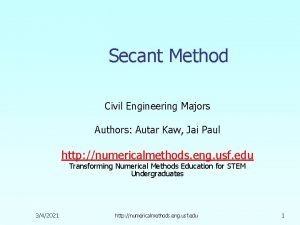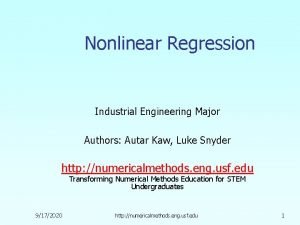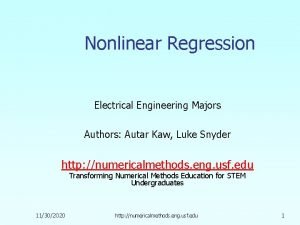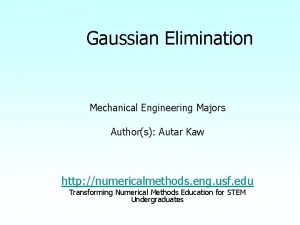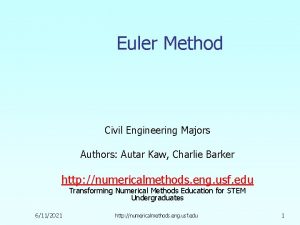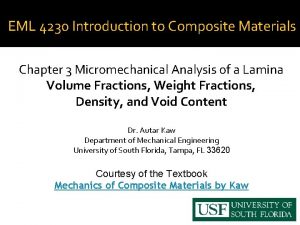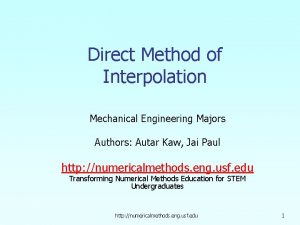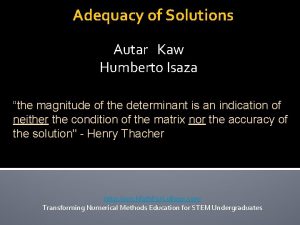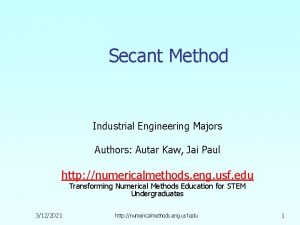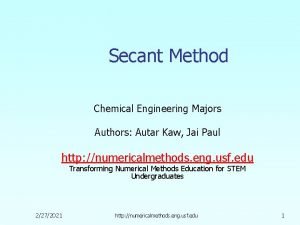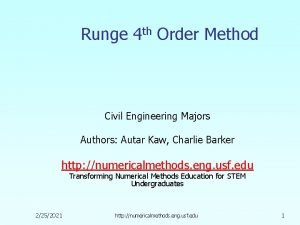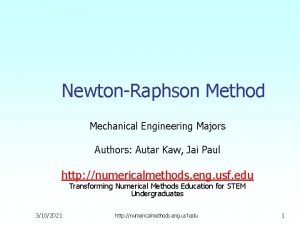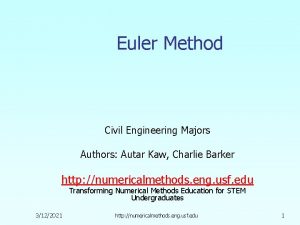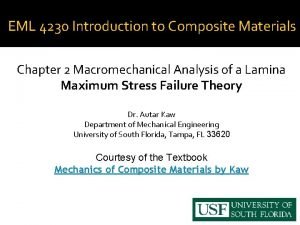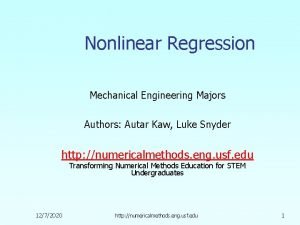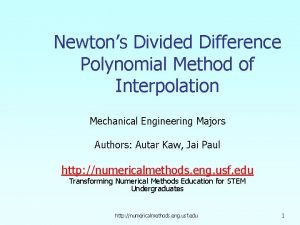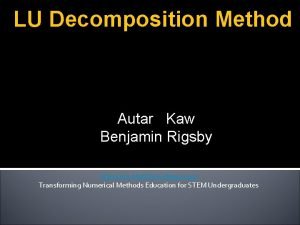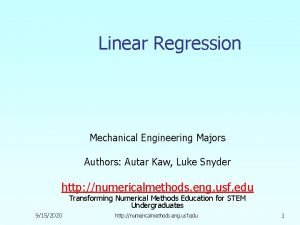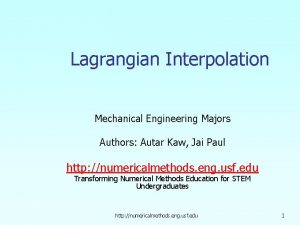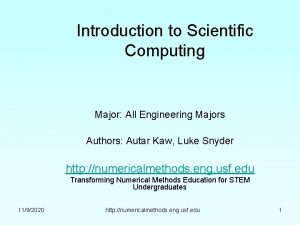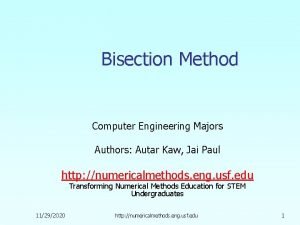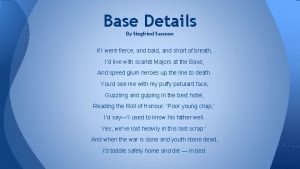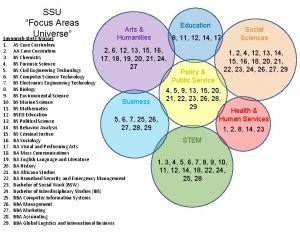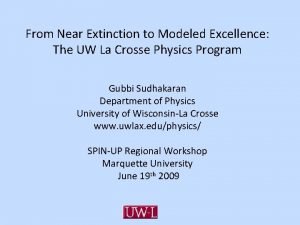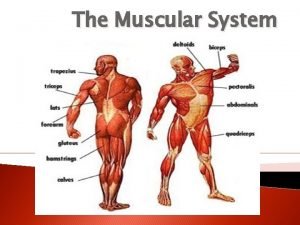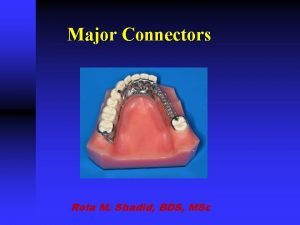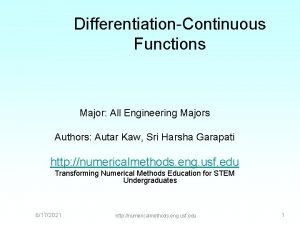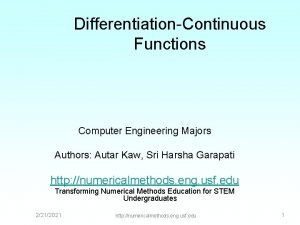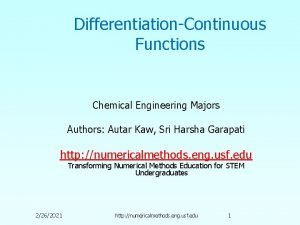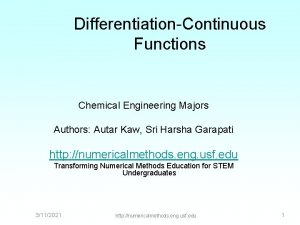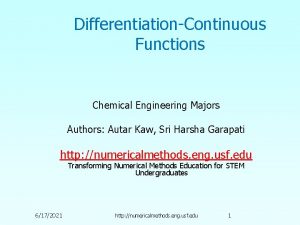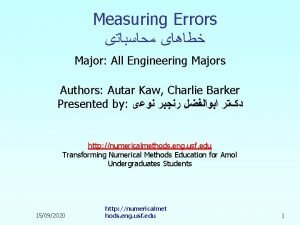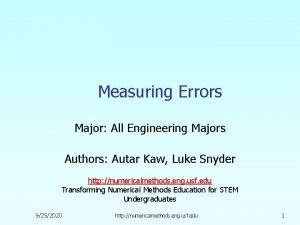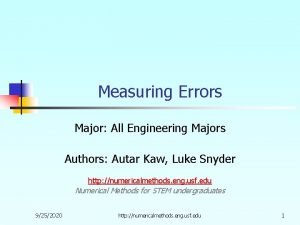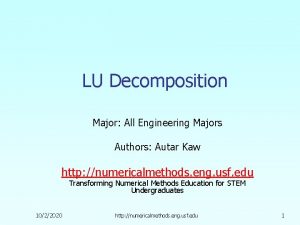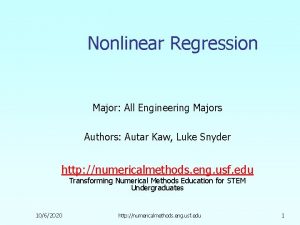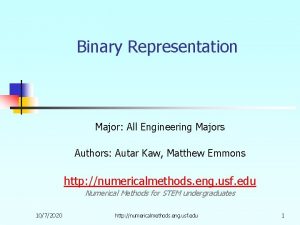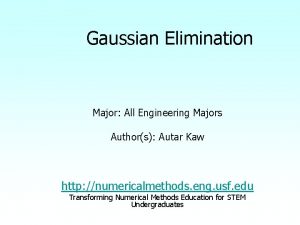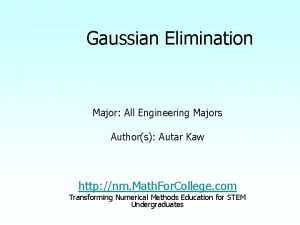DifferentiationContinuous Functions Major All Engineering Majors Authors Autar













































- Slides: 45

Differentiation-Continuous Functions Major: All Engineering Majors Authors: Autar Kaw, Sri Harsha Garapati http: //numericalmethods. eng. usf. edu Transforming Numerical Methods Education for STEM Undergraduates 2/20/2021 http: //numericalmethods. eng. usf. edu 1

Differentiation – Continuous Functions http: //numericalmethods. eng. usf. edu

Forward Difference Approximation For a finite http: //numericalme 3 thods. eng. usf. edu

Graphical Representation Of Forward Difference Approximation Figure 1 Graphical Representation of forward difference approximation of first derivative. http: //numericalme 4 thods. eng. usf. edu

Example 1 The velocity of a rocket is given by where is given in m/s and is given in seconds. a) Use forward difference approximation of the first derivative of calculate the acceleration at. Use a step size of. b) Find the exact value of the acceleration of the rocket. c) Calculate the absolute relative true error for part (b). to http: //numericalme 5 thods. eng. usf. edu

Example 1 Cont. Solution http: //numericalme 6 thods. eng. usf. edu

Example 1 Cont. Hence http: //numericalme 7 thods. eng. usf. edu

Example 1 Cont. b) The exact value of can be calculated by differentiating as http: //numericalme 8 thods. eng. usf. edu

Example 1 Cont. Knowing that and http: //numericalme 9 thods. eng. usf. edu

Example 1 Cont. The absolute relative true error is http: //numericalme 10 thods. eng. usf. edu

Backward Difference Approximation of the First Derivative We know For a finite If , is chosen as a negative number, http: //numericalme 11 thods. eng. usf. edu

Backward Difference Approximation of the First Derivative Cont. This is a backward difference approximation as you are taking a point backward from x. To find the value of at , we may choose another point behind as. This gives where http: //numericalme 12 thods. eng. usf. edu

Backward Difference Approximation of the First Derivative Cont. f(x) x x-Δx x Figure 2 Graphical Representation of backward difference approximation of first derivative http: //numericalme 13 thods. eng. usf. edu

Example 2 The velocity of a rocket is given by where is given in m/s and is given in seconds. a) Use backward difference approximation of the first derivative of to calculate the acceleration at. Use a step size of. b) Find the absolute relative true error for part (a). http: //numericalme 14 thods. eng. usf. edu

Example 2 Cont. Solution http: //numericalme 15 thods. eng. usf. edu

Example 2 Cont. http: //numericalme 16 thods. eng. usf. edu

Example 2 Cont. The exact value of the acceleration at from Example 1 is The absolute relative true error is http: //numericalme 17 thods. eng. usf. edu

Derive the forward difference approximation from Taylor series Taylor’s theorem says that if you know the value of a function at a point and all its derivatives at that point, provided the derivatives are continuous between and , then Substituting for convenience http: //numericalme 18 thods. eng. usf. edu

Derive the forward difference approximation from Taylor series Cont. The of term shows that the error in the approximation is of the order Can you now derive from Taylor series the formula for backward divided difference approximation of the first derivative? As shown above, both forward and backward divided difference approximation of the first derivative are accurate on the order of Can we get better approximations? Yes, another method to approximate the first derivative is called the Central difference approximation of the first derivative. http: //numericalme 19 thods. eng. usf. edu

Derive the forward difference approximation from Taylor series Cont. From Taylor series Subtracting equation (2) from equation (1) http: //numericalme 20 thods. eng. usf. edu

Central Divided Difference Hence showing that we have obtained a more accurate formula as the error is of the order of . f(x) x x-Δx x x+Δx Figure 3 Graphical Representation of central difference approximation of first derivative http: //numericalme 21 thods. eng. usf. edu

Example 3 The velocity of a rocket is given by where is given in m/s and is given in seconds. (a) Use central divided difference approximation of the first derivative of to calculate the acceleration at. Use a step size of. (b) Find the absolute relative true error for part (a). http: //numericalme 22 thods. eng. usf. edu

Example 3 cont. Solution http: //numericalme 23 thods. eng. usf. edu

Example 3 cont. http: //numericalme 24 thods. eng. usf. edu

Example 3 cont. The exact value of the acceleration at from Example 1 is The absolute relative true error is http: //numericalme 25 thods. eng. usf. edu

Comparision of FDD, BDD, CDD The results from the three difference approximations are given in Table 1 Summary of a (16) using different divided difference approximations Type of Difference Approximation Forward Backward Central 30. 475 28. 915 29. 695 2. 6967 2. 5584 0. 069157 http: //numericalme 26 thods. eng. usf. edu

Finding the value of the derivative within a prespecified tolerance In real life, one would not know the exact value of the derivative – so how would one know how accurately they have found the value of the derivative. A simple way would be to start with a step size and keep on halving the step size until the absolute relative approximate error is within a pre-specified tolerance. Take the example of finding at for using the backward divided difference scheme. http: //numericalme 27 thods. eng. usf. edu

Finding the value of the derivative within a prespecified tolerance Cont. Given in Table 2 are the values obtained using the backward difference approximation method and the corresponding absolute relative approximate errors. Table 2 First derivative approximations and relative errors for different Δt values of backward difference scheme 2 1 0. 5 0. 25 0. 125 28. 915 29. 289 29. 480 29. 577 29. 625 1. 2792 0. 64787 0. 32604 0. 16355 http: //numericalme 28 thods. eng. usf. edu

Finding the value of the derivative within a prespecified tolerance Cont. From the above table, one can see that the absolute relative approximate error decreases as the step size is reduced. At the absolute relative approximate error is 0. 16355%, meaning that at least 2 significant digits are correct in the answer. http: //numericalme 29 thods. eng. usf. edu

Finite Difference Approximation of Higher Derivatives One can use Taylor series to approximate a higher order derivative. For example, to approximate , the Taylor series for where http: //numericalme 30 thods. eng. usf. edu

Finite Difference Approximation of Higher Derivatives Cont. Subtracting 2 times equation (4) from equation (3) gives (5) http: //numericalme 31 thods. eng. usf. edu

Example 4 The velocity of a rocket is given by Use forward difference approximation of the second derivative to calculate the jerk at. Use a step size of. of http: //numericalme 32 thods. eng. usf. edu

Example 4 Cont. Solution http: //numericalme 33 thods. eng. usf. edu

Example 4 Cont. http: //numericalme 34 thods. eng. usf. edu

Example 4 Cont. The exact value of can be calculated by differentiating twice as and http: //numericalme 35 thods. eng. usf. edu

Example 4 Cont. Knowing that and http: //numericalme 36 thods. eng. usf. edu

Example 4 Cont. Similarly it can be shown that The absolute relative true error is http: //numericalme 37 thods. eng. usf. edu

Higher order accuracy of higher order derivatives The formula given by equation (5) is a forward difference approximation of the second derivative and has the error of the order of . Can we get a formula that has a better accuracy? We can get the central difference approximation of the second derivative. The Taylor series for (6) where http: //numericalme 38 thods. eng. usf. edu

Higher order accuracy of higher order derivatives Cont. (7) where Adding equations (6) and (7), gives http: //numericalme 39 thods. eng. usf. edu

Example 5 The velocity of a rocket is given by Use central difference approximation of second derivative of calculate the jerk at. Use a step size of. to http: //numericalme 40 thods. eng. usf. edu

Example 5 Cont. Solution http: //numericalme 41 thods. eng. usf. edu

Example 5 Cont. http: //numericalme 42 thods. eng. usf. edu

Example 5 Cont. The absolute relative true error is http: //numericalme 43 thods. eng. usf. edu

Additional Resources For all resources on this topic such as digital audiovisual lectures, primers, textbook chapters, multiple-choice tests, worksheets in MATLAB, MATHEMATICA, Math. Cad and MAPLE, blogs, related physical problems, please visit http: //numericalmethods. eng. usf. edu/topics/continuous_02 d if. html

THE END http: //numericalmethods. eng. usf. edu
 Autar kaw
Autar kaw Autar kaw
Autar kaw Autar kaw
Autar kaw Autar kaw
Autar kaw Autar kaw
Autar kaw Autar kaw
Autar kaw Autar kaw
Autar kaw Autar kaw
Autar kaw Autar kaw
Autar kaw Autar kaw
Autar kaw Autar kaw
Autar kaw Autar kaw
Autar kaw Autar kaw
Autar kaw Autar kaw
Autar kaw Euler method
Euler method Autar kaw
Autar kaw Autar kaw
Autar kaw Autar kaw
Autar kaw Autar kaw
Autar kaw Lu decomposition method
Lu decomposition method Autar kaw
Autar kaw Autar kaw
Autar kaw Autar kaw
Autar kaw Autar kaw
Autar kaw Test for english majors-band 4
Test for english majors-band 4 What does youth stone dead mean
What does youth stone dead mean Gju jordan
Gju jordan Ssu majors
Ssu majors Uwlax majors
Uwlax majors Texas state majors
Texas state majors Uwb advising appointment
Uwb advising appointment Ung dual enrollment classes
Ung dual enrollment classes Skyline college meta majors
Skyline college meta majors Wku academic advising
Wku academic advising Golden palace
Golden palace Draw three noncollinear points j k and l
Draw three noncollinear points j k and l Major engineering problems in urea production
Major engineering problems in urea production Purpose of excretory system
Purpose of excretory system What are the main functions of excretory system
What are the main functions of excretory system What are the major functions of management
What are the major functions of management A computer system consists of both hardware and software.
A computer system consists of both hardware and software. What are the major functions of the muscular system
What are the major functions of the muscular system Agency functions of commercial banks
Agency functions of commercial banks Sublingual bar
Sublingual bar Types of major connector in rpd
Types of major connector in rpd What is system in software engineering
What is system in software engineering

